Detailed Analysis of Double Ink Printers Limited Audit Report
VerifiedAdded on 2020/02/24
|10
|2397
|52
Report
AI Summary
This report presents an analysis of an audit report focusing on Double Ink Printers Limited (DIPL). It examines the audit procedures applied, including substantive and analytical procedures, to assess the company's financial statements. The report highlights the importance of risk identification and mitigation, discussing inherent, control, and detection risks. It further explores potential fraud risk factors within DIPL, emphasizing the significance of segregation of duties and proper internal controls. The analysis includes a review of financial ratios, such as current and debt-equity ratios, and their implications. The report underscores the role of the auditor in identifying and mitigating fraud risks, ensuring the accuracy and reliability of financial reporting. It emphasizes the need for professional skepticism and the application of appropriate audit techniques to provide reasonable assurance to financial statement users. The report also provides a ratio analysis of the entity for the last 3 years and makes observations from it.

By student name
Professor
University
Date: 27 August 2017.
Professor
University
Date: 27 August 2017.
Paraphrase This Document
Need a fresh take? Get an instant paraphrase of this document with our AI Paraphraser

1
Contents
Question no 1…………………………………………………………………...2
Question no 2…………………………………………………………………...6
Question no 3…………………………………………………………….....….7
Refrences.....……………………………………………………………….......9
1 | P a g e
Contents
Question no 1…………………………………………………………………...2
Question no 2…………………………………………………………………...6
Question no 3…………………………………………………………….....….7
Refrences.....……………………………………………………………….......9
1 | P a g e
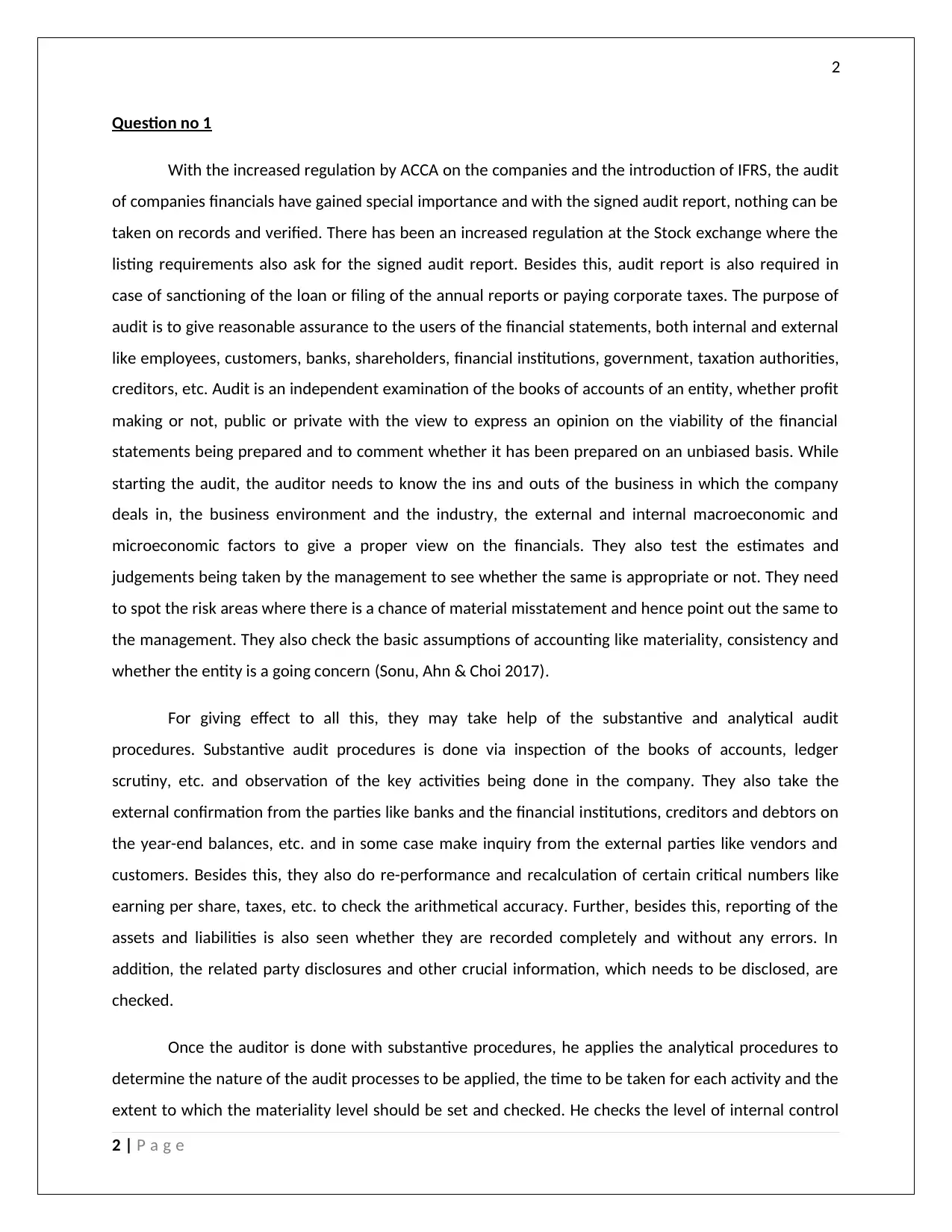
2
Question no 1
With the increased regulation by ACCA on the companies and the introduction of IFRS, the audit
of companies financials have gained special importance and with the signed audit report, nothing can be
taken on records and verified. There has been an increased regulation at the Stock exchange where the
listing requirements also ask for the signed audit report. Besides this, audit report is also required in
case of sanctioning of the loan or filing of the annual reports or paying corporate taxes. The purpose of
audit is to give reasonable assurance to the users of the financial statements, both internal and external
like employees, customers, banks, shareholders, financial institutions, government, taxation authorities,
creditors, etc. Audit is an independent examination of the books of accounts of an entity, whether profit
making or not, public or private with the view to express an opinion on the viability of the financial
statements being prepared and to comment whether it has been prepared on an unbiased basis. While
starting the audit, the auditor needs to know the ins and outs of the business in which the company
deals in, the business environment and the industry, the external and internal macroeconomic and
microeconomic factors to give a proper view on the financials. They also test the estimates and
judgements being taken by the management to see whether the same is appropriate or not. They need
to spot the risk areas where there is a chance of material misstatement and hence point out the same to
the management. They also check the basic assumptions of accounting like materiality, consistency and
whether the entity is a going concern (Sonu, Ahn & Choi 2017).
For giving effect to all this, they may take help of the substantive and analytical audit
procedures. Substantive audit procedures is done via inspection of the books of accounts, ledger
scrutiny, etc. and observation of the key activities being done in the company. They also take the
external confirmation from the parties like banks and the financial institutions, creditors and debtors on
the year-end balances, etc. and in some case make inquiry from the external parties like vendors and
customers. Besides this, they also do re-performance and recalculation of certain critical numbers like
earning per share, taxes, etc. to check the arithmetical accuracy. Further, besides this, reporting of the
assets and liabilities is also seen whether they are recorded completely and without any errors. In
addition, the related party disclosures and other crucial information, which needs to be disclosed, are
checked.
Once the auditor is done with substantive procedures, he applies the analytical procedures to
determine the nature of the audit processes to be applied, the time to be taken for each activity and the
extent to which the materiality level should be set and checked. He checks the level of internal control
2 | P a g e
Question no 1
With the increased regulation by ACCA on the companies and the introduction of IFRS, the audit
of companies financials have gained special importance and with the signed audit report, nothing can be
taken on records and verified. There has been an increased regulation at the Stock exchange where the
listing requirements also ask for the signed audit report. Besides this, audit report is also required in
case of sanctioning of the loan or filing of the annual reports or paying corporate taxes. The purpose of
audit is to give reasonable assurance to the users of the financial statements, both internal and external
like employees, customers, banks, shareholders, financial institutions, government, taxation authorities,
creditors, etc. Audit is an independent examination of the books of accounts of an entity, whether profit
making or not, public or private with the view to express an opinion on the viability of the financial
statements being prepared and to comment whether it has been prepared on an unbiased basis. While
starting the audit, the auditor needs to know the ins and outs of the business in which the company
deals in, the business environment and the industry, the external and internal macroeconomic and
microeconomic factors to give a proper view on the financials. They also test the estimates and
judgements being taken by the management to see whether the same is appropriate or not. They need
to spot the risk areas where there is a chance of material misstatement and hence point out the same to
the management. They also check the basic assumptions of accounting like materiality, consistency and
whether the entity is a going concern (Sonu, Ahn & Choi 2017).
For giving effect to all this, they may take help of the substantive and analytical audit
procedures. Substantive audit procedures is done via inspection of the books of accounts, ledger
scrutiny, etc. and observation of the key activities being done in the company. They also take the
external confirmation from the parties like banks and the financial institutions, creditors and debtors on
the year-end balances, etc. and in some case make inquiry from the external parties like vendors and
customers. Besides this, they also do re-performance and recalculation of certain critical numbers like
earning per share, taxes, etc. to check the arithmetical accuracy. Further, besides this, reporting of the
assets and liabilities is also seen whether they are recorded completely and without any errors. In
addition, the related party disclosures and other crucial information, which needs to be disclosed, are
checked.
Once the auditor is done with substantive procedures, he applies the analytical procedures to
determine the nature of the audit processes to be applied, the time to be taken for each activity and the
extent to which the materiality level should be set and checked. He checks the level of internal control
2 | P a g e
⊘ This is a preview!⊘
Do you want full access?
Subscribe today to unlock all pages.

Trusted by 1+ million students worldwide
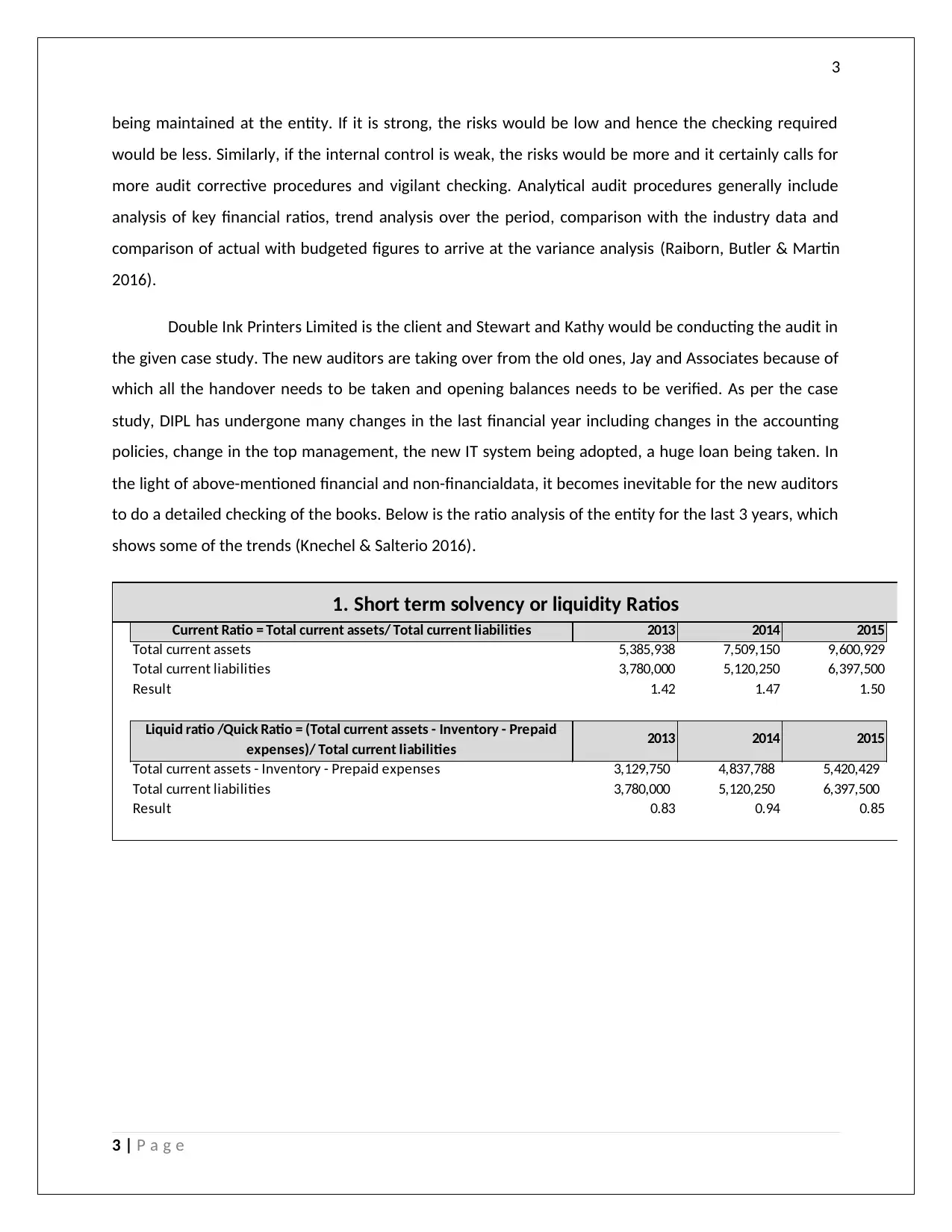
3
being maintained at the entity. If it is strong, the risks would be low and hence the checking required
would be less. Similarly, if the internal control is weak, the risks would be more and it certainly calls for
more audit corrective procedures and vigilant checking. Analytical audit procedures generally include
analysis of key financial ratios, trend analysis over the period, comparison with the industry data and
comparison of actual with budgeted figures to arrive at the variance analysis (Raiborn, Butler & Martin
2016).
Double Ink Printers Limited is the client and Stewart and Kathy would be conducting the audit in
the given case study. The new auditors are taking over from the old ones, Jay and Associates because of
which all the handover needs to be taken and opening balances needs to be verified. As per the case
study, DIPL has undergone many changes in the last financial year including changes in the accounting
policies, change in the top management, the new IT system being adopted, a huge loan being taken. In
the light of above-mentioned financial and non-financialdata, it becomes inevitable for the new auditors
to do a detailed checking of the books. Below is the ratio analysis of the entity for the last 3 years, which
shows some of the trends (Knechel & Salterio 2016).
2013 2014 2015
Total current assets 5,385,938 7,509,150 9,600,929
Total current liabilities 3,780,000 5,120,250 6,397,500
Result 1.42 1.47 1.50
2013 2014 2015
Total current assets - Inventory - Prepaid expenses 3,129,750 4,837,788 5,420,429
Total current liabilities 3,780,000 5,120,250 6,397,500
Result 0.83 0.94 0.85
Current Ratio = Total current assets/ Total current liabilities
Liquid ratio /Quick Ratio = (Total current assets - Inventory - Prepaid
expenses)/ Total current liabilities
1. Short term solvency or liquidity Ratios
3 | P a g e
being maintained at the entity. If it is strong, the risks would be low and hence the checking required
would be less. Similarly, if the internal control is weak, the risks would be more and it certainly calls for
more audit corrective procedures and vigilant checking. Analytical audit procedures generally include
analysis of key financial ratios, trend analysis over the period, comparison with the industry data and
comparison of actual with budgeted figures to arrive at the variance analysis (Raiborn, Butler & Martin
2016).
Double Ink Printers Limited is the client and Stewart and Kathy would be conducting the audit in
the given case study. The new auditors are taking over from the old ones, Jay and Associates because of
which all the handover needs to be taken and opening balances needs to be verified. As per the case
study, DIPL has undergone many changes in the last financial year including changes in the accounting
policies, change in the top management, the new IT system being adopted, a huge loan being taken. In
the light of above-mentioned financial and non-financialdata, it becomes inevitable for the new auditors
to do a detailed checking of the books. Below is the ratio analysis of the entity for the last 3 years, which
shows some of the trends (Knechel & Salterio 2016).
2013 2014 2015
Total current assets 5,385,938 7,509,150 9,600,929
Total current liabilities 3,780,000 5,120,250 6,397,500
Result 1.42 1.47 1.50
2013 2014 2015
Total current assets - Inventory - Prepaid expenses 3,129,750 4,837,788 5,420,429
Total current liabilities 3,780,000 5,120,250 6,397,500
Result 0.83 0.94 0.85
Current Ratio = Total current assets/ Total current liabilities
Liquid ratio /Quick Ratio = (Total current assets - Inventory - Prepaid
expenses)/ Total current liabilities
1. Short term solvency or liquidity Ratios
3 | P a g e
Paraphrase This Document
Need a fresh take? Get an instant paraphrase of this document with our AI Paraphraser
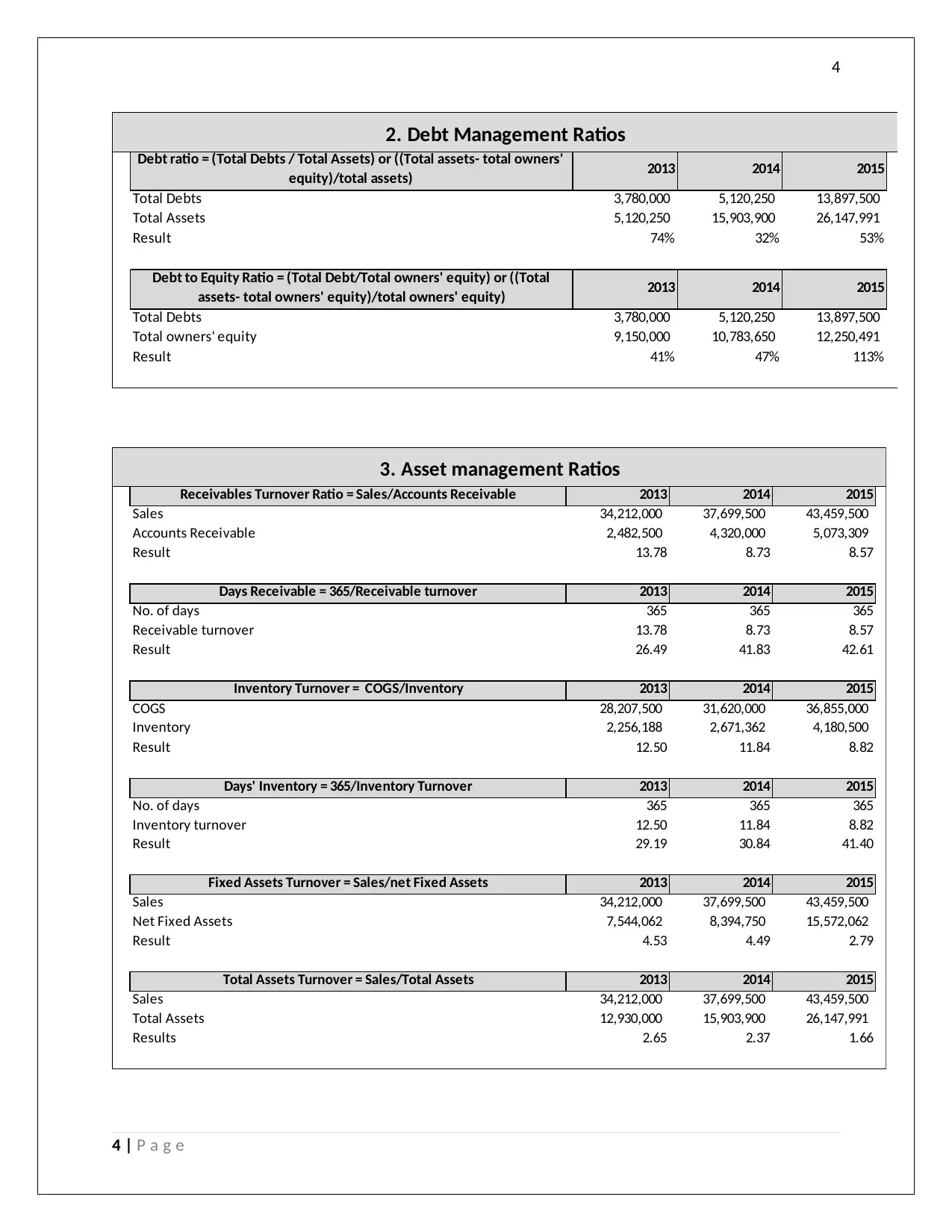
4
2013 2014 2015
Total Debts 3,780,000 5,120,250 13,897,500
Total Assets 5,120,250 15,903,900 26,147,991
Result 74% 32% 53%
2013 2014 2015
Total Debts 3,780,000 5,120,250 13,897,500
Total owners' equity 9,150,000 10,783,650 12,250,491
Result 41% 47% 113%
Debt ratio = (Total Debts / Total Assets) or ((Total assets- total owners'
equity)/total assets)
Debt to Equity Ratio = (Total Debt/Total owners' equity) or ((Total
assets- total owners' equity)/total owners' equity)
2. Debt Management Ratios
2013 2014 2015
Sales 34,212,000 37,699,500 43,459,500
Accounts Receivable 2,482,500 4,320,000 5,073,309
Result 13.78 8.73 8.57
2013 2014 2015
No. of days 365 365 365
Receivable turnover 13.78 8.73 8.57
Result 26.49 41.83 42.61
2013 2014 2015
COGS 28,207,500 31,620,000 36,855,000
Inventory 2,256,188 2,671,362 4,180,500
Result 12.50 11.84 8.82
2013 2014 2015
No. of days 365 365 365
Inventory turnover 12.50 11.84 8.82
Result 29.19 30.84 41.40
2013 2014 2015
Sales 34,212,000 37,699,500 43,459,500
Net Fixed Assets 7,544,062 8,394,750 15,572,062
Result 4.53 4.49 2.79
2013 2014 2015
Sales 34,212,000 37,699,500 43,459,500
Total Assets 12,930,000 15,903,900 26,147,991
Results 2.65 2.37 1.66
Inventory Turnover = COGS/Inventory
Days' Inventory = 365/Inventory Turnover
Fixed Assets Turnover = Sales/net Fixed Assets
Total Assets Turnover = Sales/Total Assets
Receivables Turnover Ratio = Sales/Accounts Receivable
Days Receivable = 365/Receivable turnover
3. Asset management Ratios
4 | P a g e
2013 2014 2015
Total Debts 3,780,000 5,120,250 13,897,500
Total Assets 5,120,250 15,903,900 26,147,991
Result 74% 32% 53%
2013 2014 2015
Total Debts 3,780,000 5,120,250 13,897,500
Total owners' equity 9,150,000 10,783,650 12,250,491
Result 41% 47% 113%
Debt ratio = (Total Debts / Total Assets) or ((Total assets- total owners'
equity)/total assets)
Debt to Equity Ratio = (Total Debt/Total owners' equity) or ((Total
assets- total owners' equity)/total owners' equity)
2. Debt Management Ratios
2013 2014 2015
Sales 34,212,000 37,699,500 43,459,500
Accounts Receivable 2,482,500 4,320,000 5,073,309
Result 13.78 8.73 8.57
2013 2014 2015
No. of days 365 365 365
Receivable turnover 13.78 8.73 8.57
Result 26.49 41.83 42.61
2013 2014 2015
COGS 28,207,500 31,620,000 36,855,000
Inventory 2,256,188 2,671,362 4,180,500
Result 12.50 11.84 8.82
2013 2014 2015
No. of days 365 365 365
Inventory turnover 12.50 11.84 8.82
Result 29.19 30.84 41.40
2013 2014 2015
Sales 34,212,000 37,699,500 43,459,500
Net Fixed Assets 7,544,062 8,394,750 15,572,062
Result 4.53 4.49 2.79
2013 2014 2015
Sales 34,212,000 37,699,500 43,459,500
Total Assets 12,930,000 15,903,900 26,147,991
Results 2.65 2.37 1.66
Inventory Turnover = COGS/Inventory
Days' Inventory = 365/Inventory Turnover
Fixed Assets Turnover = Sales/net Fixed Assets
Total Assets Turnover = Sales/Total Assets
Receivables Turnover Ratio = Sales/Accounts Receivable
Days Receivable = 365/Receivable turnover
3. Asset management Ratios
4 | P a g e

5
2013 2014 2015
Net income 2,359,190 2,291,362 2,972,183
Sales 34,212,000 37,699,500 43,459,500
Result 6.90% 6.08% 6.84%
2013 2014 2015
Operating Profit 6,780,000 7,230,000 8,308,088
Sales 34,212,000 37,699,500 43,459,500
Result 19.82% 19.18% 19.12%
2013 2014 2015
Net income 2,359,190 2,291,362 2,972,183
Total owners' equity 9,150,000 10,783,650 12,250,491
Result 25.78% 21.25% 24.26%
Profit Margin / Net Profit ratio = Net income / Sales
Operating Margin ratio = Operating Profit/Sales
Return on Equity = Net income/total owners' equity
4. Profitability ratios
Observations from Ratio Analysis:
1. Here the current ratio as well as the liquid ratio has just about reached near the industry
standard of two&one respectively. However, it is still to achieve in the future. In addition, since
as per the loan agreement with BDO Finance Ltd., current ratio was to be at least 1.5, which the
company was just about reached in 2015.
2. The Debt equity ratio here has increased from 0.4:1 to 1.13:1 over the period of 3 years, which is
still below the industry standards of 2:1, but as per the loan agreement, the ratio was required
to be within one, which has been crossed in 2015 financial year.
3. Asset management ratios show a drastic fall in both the receivables cycle and the inventory
turnover cycle as both of them increased by around 50%, which shows that the company has
not been able to maintain effectivity over the business cycle and the control procedures have
not been as was required.
4. All the three ratios calculated here are evident of the fact that the ratios have been stagnant in
the last 3 years near to 6% and has neither increased or decreased even after taking benefit of
increased loan in the capital structure (Jones 2017).
5 | P a g e
2013 2014 2015
Net income 2,359,190 2,291,362 2,972,183
Sales 34,212,000 37,699,500 43,459,500
Result 6.90% 6.08% 6.84%
2013 2014 2015
Operating Profit 6,780,000 7,230,000 8,308,088
Sales 34,212,000 37,699,500 43,459,500
Result 19.82% 19.18% 19.12%
2013 2014 2015
Net income 2,359,190 2,291,362 2,972,183
Total owners' equity 9,150,000 10,783,650 12,250,491
Result 25.78% 21.25% 24.26%
Profit Margin / Net Profit ratio = Net income / Sales
Operating Margin ratio = Operating Profit/Sales
Return on Equity = Net income/total owners' equity
4. Profitability ratios
Observations from Ratio Analysis:
1. Here the current ratio as well as the liquid ratio has just about reached near the industry
standard of two&one respectively. However, it is still to achieve in the future. In addition, since
as per the loan agreement with BDO Finance Ltd., current ratio was to be at least 1.5, which the
company was just about reached in 2015.
2. The Debt equity ratio here has increased from 0.4:1 to 1.13:1 over the period of 3 years, which is
still below the industry standards of 2:1, but as per the loan agreement, the ratio was required
to be within one, which has been crossed in 2015 financial year.
3. Asset management ratios show a drastic fall in both the receivables cycle and the inventory
turnover cycle as both of them increased by around 50%, which shows that the company has
not been able to maintain effectivity over the business cycle and the control procedures have
not been as was required.
4. All the three ratios calculated here are evident of the fact that the ratios have been stagnant in
the last 3 years near to 6% and has neither increased or decreased even after taking benefit of
increased loan in the capital structure (Jones 2017).
5 | P a g e
⊘ This is a preview!⊘
Do you want full access?
Subscribe today to unlock all pages.

Trusted by 1+ million students worldwide

6
Solution 2
Risk identification and mitigation is an important aspect of auditing. It is important that while
conducting the audit, the auditor must apply proper judgement and professional scepticism to make
sure that all kinds of risk is properly identified and the auditor must take care to inform the man agent
for the same. The management must also ascertain that proper internal control measures are there, so
that all kinds of risk elements are properly eliminated. There are three types of risk, inherent risks that
occurs when things are not there in hands of the management, even if proper internal control is
maintained. Control risks occur when the management has not maintained proper internal control
measures that expose the entity to certain kind of risk. In addition, the detection risk, occurs when the
auditor fails to detect certain risks and errors (Grenier 2017).
In the given case of DIPL, there are two types of inherent risk. The first risk is associated with
the adoption of non-routine matter that is deviation from the general procedures that are followed by
the company. The CEO of the company wants to adopt new methods of valuation of inventory and
calculation of total depreciation. The life of the asset as per the rules of the industry must be taken as 30
years, but the company wants to adopt the total life as 20 years. Thus, we see that the management is
deviating from the routine matters, which might leads to risk of material misstatement. It may lead to
undervaluation or overvaluation of the assets in the financial statements. It is thus important that
before undertaking such steps, proper research must be conducted by the company. It is important that
the auditor must check all the records, and in case new measures are adopted, the auditor must give
proper disclosure in the books of the account. The second case of inherent risk that is associated with
the company is in the adoption of new IT system, and the company adopts the same without conducting
any kind of research by the management. This is case where we see that the management has taken a
decision without taking any expert advice and that might lead to overvaluation or undervaluation of the
new system. It may lead to risk of material misstatement and that may affect the overall profit of the
company. The management should make changes only when it is hindered percent sure about its
validity and then implent the same. The results after implementation must also be monitored so that
any case of misevaluation may be ascertained. This in these areas there are no proper control by the
management and thus leads to inherent risk on part of the company (Fay & Negangard 2017).
6 | P a g e
Solution 2
Risk identification and mitigation is an important aspect of auditing. It is important that while
conducting the audit, the auditor must apply proper judgement and professional scepticism to make
sure that all kinds of risk is properly identified and the auditor must take care to inform the man agent
for the same. The management must also ascertain that proper internal control measures are there, so
that all kinds of risk elements are properly eliminated. There are three types of risk, inherent risks that
occurs when things are not there in hands of the management, even if proper internal control is
maintained. Control risks occur when the management has not maintained proper internal control
measures that expose the entity to certain kind of risk. In addition, the detection risk, occurs when the
auditor fails to detect certain risks and errors (Grenier 2017).
In the given case of DIPL, there are two types of inherent risk. The first risk is associated with
the adoption of non-routine matter that is deviation from the general procedures that are followed by
the company. The CEO of the company wants to adopt new methods of valuation of inventory and
calculation of total depreciation. The life of the asset as per the rules of the industry must be taken as 30
years, but the company wants to adopt the total life as 20 years. Thus, we see that the management is
deviating from the routine matters, which might leads to risk of material misstatement. It may lead to
undervaluation or overvaluation of the assets in the financial statements. It is thus important that
before undertaking such steps, proper research must be conducted by the company. It is important that
the auditor must check all the records, and in case new measures are adopted, the auditor must give
proper disclosure in the books of the account. The second case of inherent risk that is associated with
the company is in the adoption of new IT system, and the company adopts the same without conducting
any kind of research by the management. This is case where we see that the management has taken a
decision without taking any expert advice and that might lead to overvaluation or undervaluation of the
new system. It may lead to risk of material misstatement and that may affect the overall profit of the
company. The management should make changes only when it is hindered percent sure about its
validity and then implent the same. The results after implementation must also be monitored so that
any case of misevaluation may be ascertained. This in these areas there are no proper control by the
management and thus leads to inherent risk on part of the company (Fay & Negangard 2017).
6 | P a g e
Paraphrase This Document
Need a fresh take? Get an instant paraphrase of this document with our AI Paraphraser
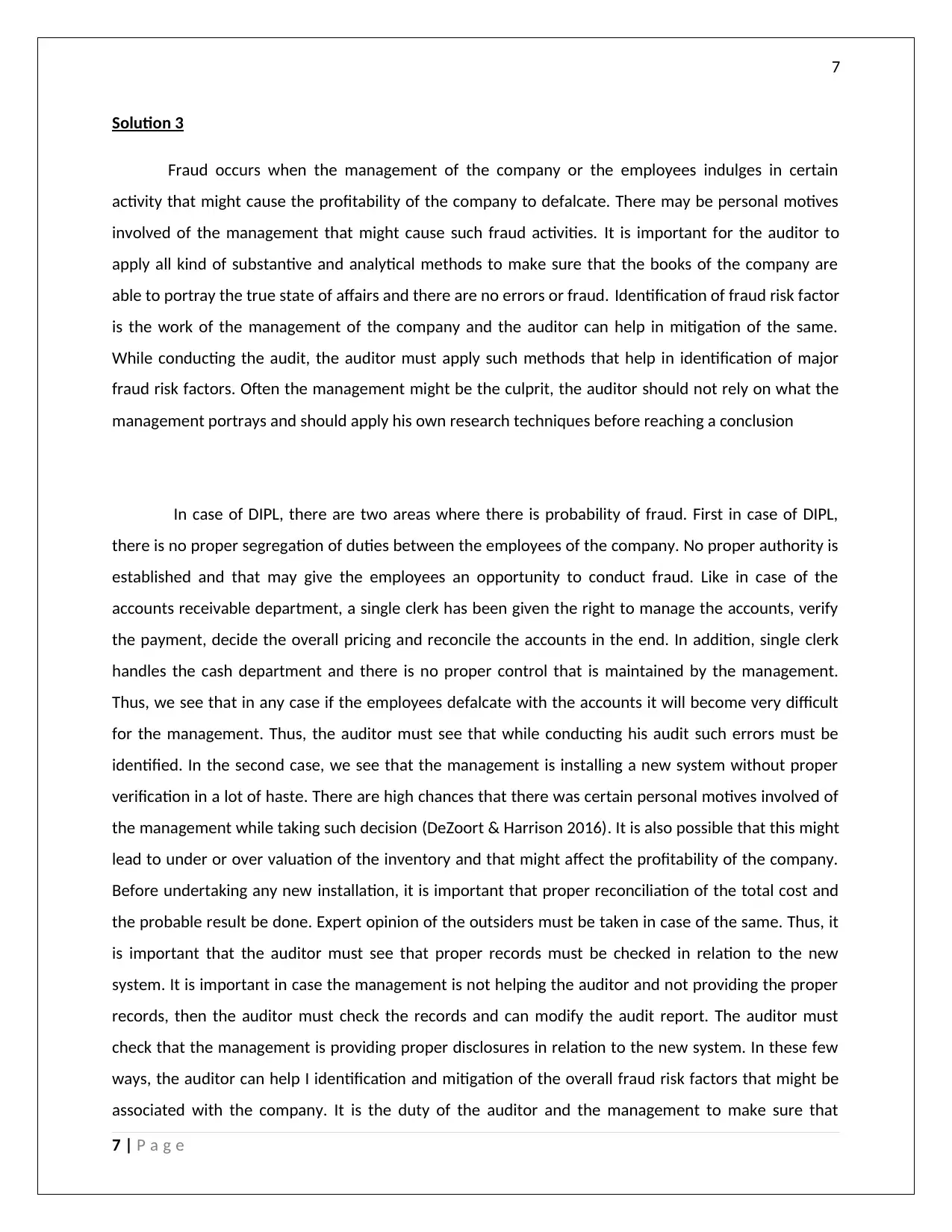
7
Solution 3
Fraud occurs when the management of the company or the employees indulges in certain
activity that might cause the profitability of the company to defalcate. There may be personal motives
involved of the management that might cause such fraud activities. It is important for the auditor to
apply all kind of substantive and analytical methods to make sure that the books of the company are
able to portray the true state of affairs and there are no errors or fraud. Identification of fraud risk factor
is the work of the management of the company and the auditor can help in mitigation of the same.
While conducting the audit, the auditor must apply such methods that help in identification of major
fraud risk factors. Often the management might be the culprit, the auditor should not rely on what the
management portrays and should apply his own research techniques before reaching a conclusion
In case of DIPL, there are two areas where there is probability of fraud. First in case of DIPL,
there is no proper segregation of duties between the employees of the company. No proper authority is
established and that may give the employees an opportunity to conduct fraud. Like in case of the
accounts receivable department, a single clerk has been given the right to manage the accounts, verify
the payment, decide the overall pricing and reconcile the accounts in the end. In addition, single clerk
handles the cash department and there is no proper control that is maintained by the management.
Thus, we see that in any case if the employees defalcate with the accounts it will become very difficult
for the management. Thus, the auditor must see that while conducting his audit such errors must be
identified. In the second case, we see that the management is installing a new system without proper
verification in a lot of haste. There are high chances that there was certain personal motives involved of
the management while taking such decision (DeZoort & Harrison 2016). It is also possible that this might
lead to under or over valuation of the inventory and that might affect the profitability of the company.
Before undertaking any new installation, it is important that proper reconciliation of the total cost and
the probable result be done. Expert opinion of the outsiders must be taken in case of the same. Thus, it
is important that the auditor must see that proper records must be checked in relation to the new
system. It is important in case the management is not helping the auditor and not providing the proper
records, then the auditor must check the records and can modify the audit report. The auditor must
check that the management is providing proper disclosures in relation to the new system. In these few
ways, the auditor can help I identification and mitigation of the overall fraud risk factors that might be
associated with the company. It is the duty of the auditor and the management to make sure that
7 | P a g e
Solution 3
Fraud occurs when the management of the company or the employees indulges in certain
activity that might cause the profitability of the company to defalcate. There may be personal motives
involved of the management that might cause such fraud activities. It is important for the auditor to
apply all kind of substantive and analytical methods to make sure that the books of the company are
able to portray the true state of affairs and there are no errors or fraud. Identification of fraud risk factor
is the work of the management of the company and the auditor can help in mitigation of the same.
While conducting the audit, the auditor must apply such methods that help in identification of major
fraud risk factors. Often the management might be the culprit, the auditor should not rely on what the
management portrays and should apply his own research techniques before reaching a conclusion
In case of DIPL, there are two areas where there is probability of fraud. First in case of DIPL,
there is no proper segregation of duties between the employees of the company. No proper authority is
established and that may give the employees an opportunity to conduct fraud. Like in case of the
accounts receivable department, a single clerk has been given the right to manage the accounts, verify
the payment, decide the overall pricing and reconcile the accounts in the end. In addition, single clerk
handles the cash department and there is no proper control that is maintained by the management.
Thus, we see that in any case if the employees defalcate with the accounts it will become very difficult
for the management. Thus, the auditor must see that while conducting his audit such errors must be
identified. In the second case, we see that the management is installing a new system without proper
verification in a lot of haste. There are high chances that there was certain personal motives involved of
the management while taking such decision (DeZoort & Harrison 2016). It is also possible that this might
lead to under or over valuation of the inventory and that might affect the profitability of the company.
Before undertaking any new installation, it is important that proper reconciliation of the total cost and
the probable result be done. Expert opinion of the outsiders must be taken in case of the same. Thus, it
is important that the auditor must see that proper records must be checked in relation to the new
system. It is important in case the management is not helping the auditor and not providing the proper
records, then the auditor must check the records and can modify the audit report. The auditor must
check that the management is providing proper disclosures in relation to the new system. In these few
ways, the auditor can help I identification and mitigation of the overall fraud risk factors that might be
associated with the company. It is the duty of the auditor and the management to make sure that
7 | P a g e
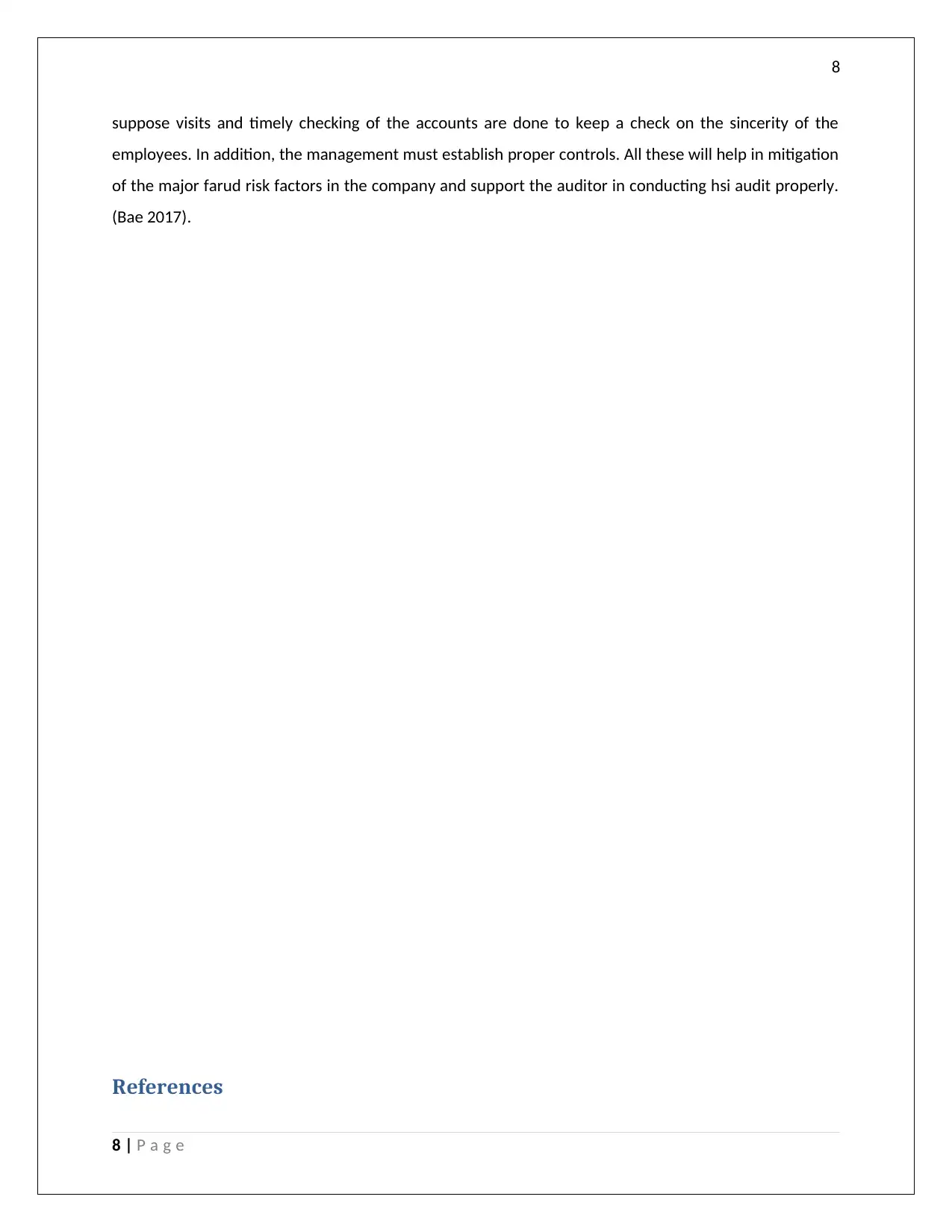
8
suppose visits and timely checking of the accounts are done to keep a check on the sincerity of the
employees. In addition, the management must establish proper controls. All these will help in mitigation
of the major farud risk factors in the company and support the auditor in conducting hsi audit properly.
(Bae 2017).
References
8 | P a g e
suppose visits and timely checking of the accounts are done to keep a check on the sincerity of the
employees. In addition, the management must establish proper controls. All these will help in mitigation
of the major farud risk factors in the company and support the auditor in conducting hsi audit properly.
(Bae 2017).
References
8 | P a g e
⊘ This is a preview!⊘
Do you want full access?
Subscribe today to unlock all pages.

Trusted by 1+ million students worldwide
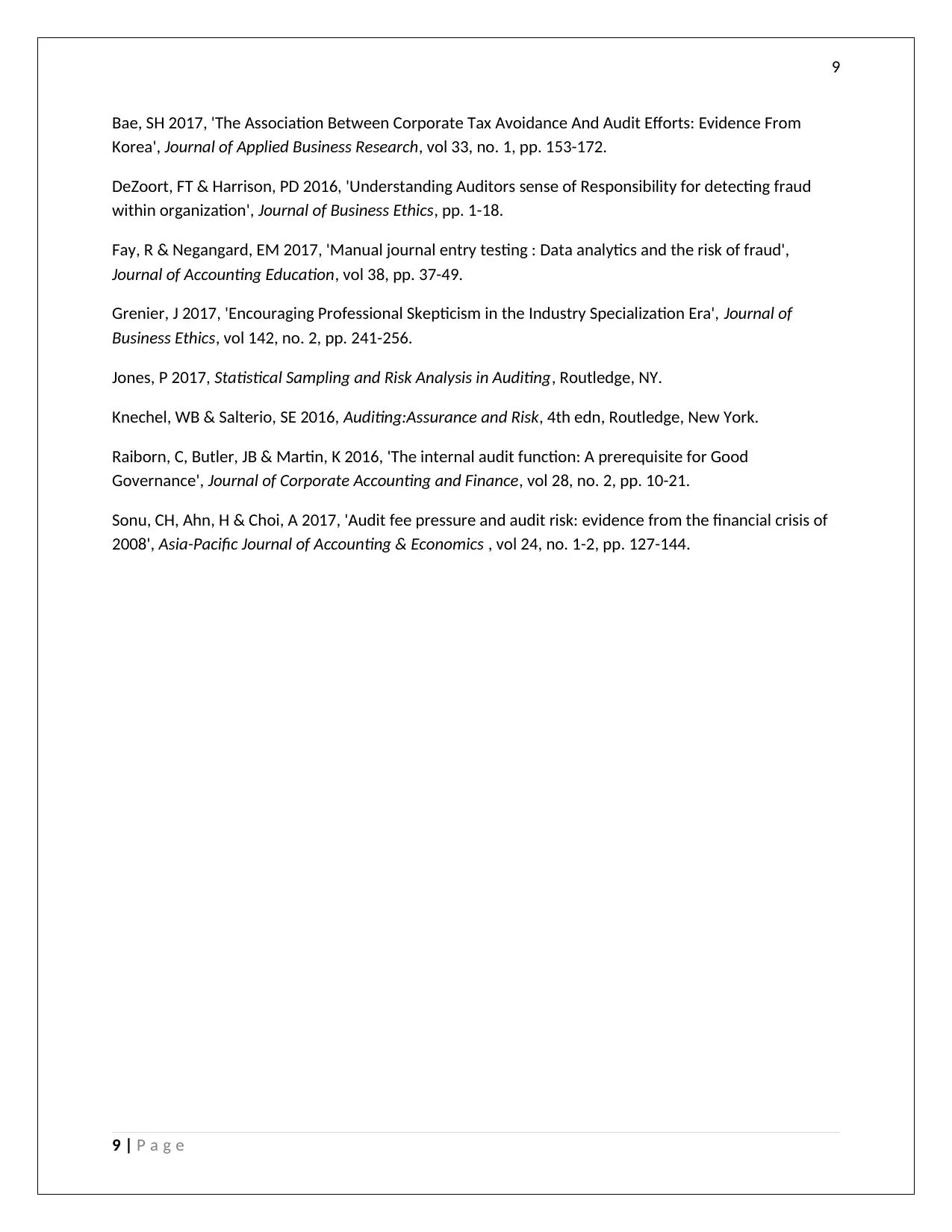
9
Bae, SH 2017, 'The Association Between Corporate Tax Avoidance And Audit Efforts: Evidence From
Korea', Journal of Applied Business Research, vol 33, no. 1, pp. 153-172.
DeZoort, FT & Harrison, PD 2016, 'Understanding Auditors sense of Responsibility for detecting fraud
within organization', Journal of Business Ethics, pp. 1-18.
Fay, R & Negangard, EM 2017, 'Manual journal entry testing : Data analytics and the risk of fraud',
Journal of Accounting Education, vol 38, pp. 37-49.
Grenier, J 2017, 'Encouraging Professional Skepticism in the Industry Specialization Era', Journal of
Business Ethics, vol 142, no. 2, pp. 241-256.
Jones, P 2017, Statistical Sampling and Risk Analysis in Auditing, Routledge, NY.
Knechel, WB & Salterio, SE 2016, Auditing:Assurance and Risk, 4th edn, Routledge, New York.
Raiborn, C, Butler, JB & Martin, K 2016, 'The internal audit function: A prerequisite for Good
Governance', Journal of Corporate Accounting and Finance, vol 28, no. 2, pp. 10-21.
Sonu, CH, Ahn, H & Choi, A 2017, 'Audit fee pressure and audit risk: evidence from the financial crisis of
2008', Asia-Pacific Journal of Accounting & Economics , vol 24, no. 1-2, pp. 127-144.
9 | P a g e
Bae, SH 2017, 'The Association Between Corporate Tax Avoidance And Audit Efforts: Evidence From
Korea', Journal of Applied Business Research, vol 33, no. 1, pp. 153-172.
DeZoort, FT & Harrison, PD 2016, 'Understanding Auditors sense of Responsibility for detecting fraud
within organization', Journal of Business Ethics, pp. 1-18.
Fay, R & Negangard, EM 2017, 'Manual journal entry testing : Data analytics and the risk of fraud',
Journal of Accounting Education, vol 38, pp. 37-49.
Grenier, J 2017, 'Encouraging Professional Skepticism in the Industry Specialization Era', Journal of
Business Ethics, vol 142, no. 2, pp. 241-256.
Jones, P 2017, Statistical Sampling and Risk Analysis in Auditing, Routledge, NY.
Knechel, WB & Salterio, SE 2016, Auditing:Assurance and Risk, 4th edn, Routledge, New York.
Raiborn, C, Butler, JB & Martin, K 2016, 'The internal audit function: A prerequisite for Good
Governance', Journal of Corporate Accounting and Finance, vol 28, no. 2, pp. 10-21.
Sonu, CH, Ahn, H & Choi, A 2017, 'Audit fee pressure and audit risk: evidence from the financial crisis of
2008', Asia-Pacific Journal of Accounting & Economics , vol 24, no. 1-2, pp. 127-144.
9 | P a g e
1 out of 10
Related Documents
Your All-in-One AI-Powered Toolkit for Academic Success.
+13062052269
info@desklib.com
Available 24*7 on WhatsApp / Email
![[object Object]](/_next/static/media/star-bottom.7253800d.svg)
Unlock your academic potential
Copyright © 2020–2025 A2Z Services. All Rights Reserved. Developed and managed by ZUCOL.





